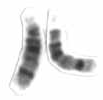
Photo from wikipedia
Genome structural variants (SVs) have larger effect on human genome functions than single nucleotide variants (SNVs). Although short-read sequencing (SRS) is current major next generation sequencing method and has given… Click to show full abstract
Genome structural variants (SVs) have larger effect on human genome functions than single nucleotide variants (SNVs). Although short-read sequencing (SRS) is current major next generation sequencing method and has given us a great benefit to elucidate the genetic background of inherited diseases, it does not detect SVs accurately. Long-read sequencing (LRS) produces tens to thousands of kilobases reads and detects the breakpoints of complex SVs. This study aimed to confirm a large deletion, which was suspected by SRS, using LRS by Oxford Nanopore technology (ONT). Genomic libraries for SRS was prepared with HaloPlex. Targeted SRS was performed for 58 genes with MiSeq. Genomic libraries for LRS were prepared using the Ligation sequencing 1D kit SQK-LSK109 (ONT). Whole genome LRS was performed with GridION X5 and R9.4 flow cells (ONT). The patient was a five-month-old boy with atrial septal defect (ASD) and atrial tachycardia. Though SRS failed to identify any causative SNVs, the results with SureCall software (Agilent) suspected a deletion between exon 3 to exon 26 in MYH6 encoding α heavy chains of cardiac myosin. The variants in MYH6 are known to be associated with ASD. Because a deletion between MYH6 exon 26 and MYH7 exon 27 was reported as esv2748480 on the Database of Genomic Variants, we performed long-range PCR from MYH6 intron26 to MYH7 exon26 and found an abnormal 1.5K bases PCR product only in the case. Due to high homology of MYH6 and MYH7, Sanger sequencing failed to detect the break point. In LRS, 3 flow cells generated 3.8M base-called reads containing 42G bases with N50 of 13K bases. We used NGMLR, which is a long-read mapper, to align the reads to the human reference genome (hg38). SVs were called by Sniffles detecting all types of SVs. The deletion was found to range from chr14: 23390037 to 23419824 (see figure) and did not contain other SVs. There was no pathogenic SV on ACTC1, GATA4, TBX20 and TLL1 which are genes related to ASD on Genetic Testing Registry. His mother had also ASD and harbored the same deletion. This is the first report to identify a large deletion between MYH6 and MYH7 in the family with ASD. The combination of SRS and LRS is useful to detect SVs in patients with suspected inherited diseases but carried no causative SNVs. Type of funding source: None
Journal Title: European Heart Journal
Year Published: 2020
Link to full text (if available)
Share on Social Media: Sign Up to like & get
recommendations!